Saturday, September 17, 2005
Silvered Æ antoninianus, Gallienus, Rome, Göbl 586b
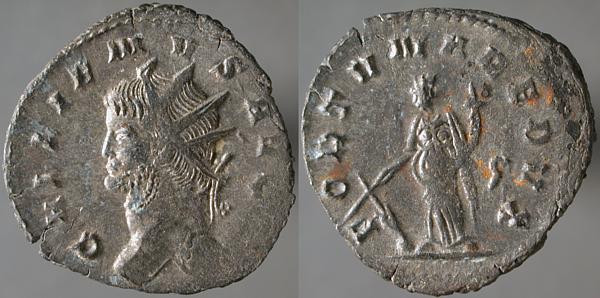
GALLIENVS AVG, Radiate head left | FORTVNA REDVX, Fortuna standing left, holding rudder on globe left, and cornucopia right. Digamma in right field.
Left-facing busts of Gallienus aren't rare, but they're always in the minority. Whether they have some significance or are just the product of left-handed engravers isn't a certain matter. The faces are enough different from those on right-facing busts that they do seem to be the work of other hands.
Friday, September 16, 2005
Æ29, Tyre in Phoenicia, Valerian, cf. Lindgren & Kovacs 2399
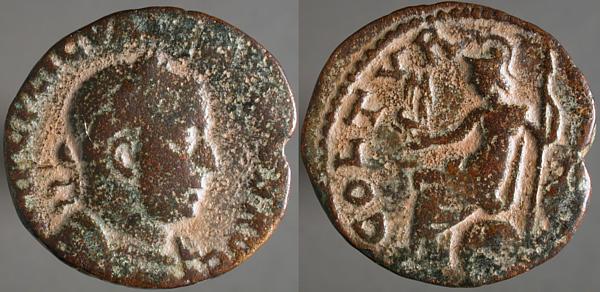
IMP C P LIC VAL[...] AVG, Laureate cuirassed bust right | COL TVR[...], Roma seated left, holding Nike left and scepter right. Murex shell in extreme right field.
Like Heliopolis, the origin of Tuesday's coin, Tyre is today the site of a city in Lebanon, a city somewhat depressed since demand for Tyrian Purple decreased.
Thursday, September 15, 2005
Billon antoninianus, Gallienus, Rome, Göbl 86q
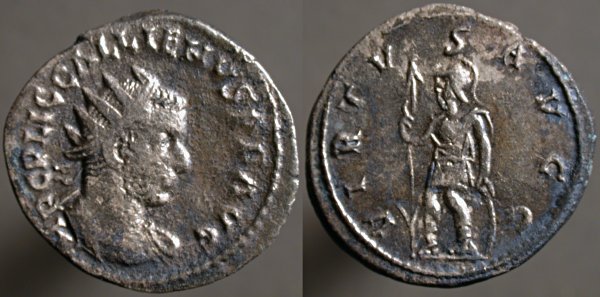
IMP C P LIC GALLIENVS P F AVG, Radiate cuirassed bust right, both ribbons behind | VIRTVS AVGG, Mars standing facing, head left, holding reversed spear left, leaning on shield right.
As coins from early in an emperor's reign often do, this has a very long and complete obverse legend, indicating IMPerator Caesar Pvblivs LICinivs GALLIENVS Pivs Felix AVGvstvs.
By the end of the reign, the legend used on coins of Gallienus was shortened to GALLIENVS AVG.
Wednesday, September 14, 2005
Æ antoninianus, Aurelian, Cyzikus, RIC 369
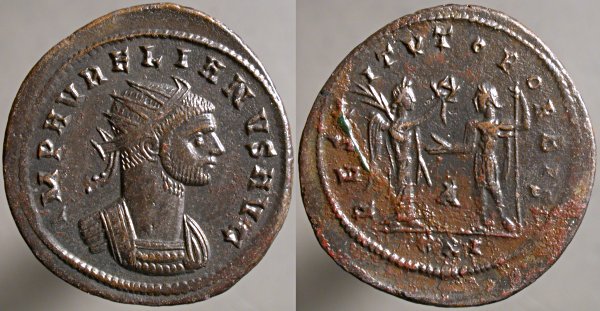
IMP AVRELIANVS AVG, Radiate cuirassed bust right | RESTITVTOR ORBIS, Victory, left, standing right, presenting wreath to Aurelian, right, standing left, holding scepter right. A between figures, XXI in exergue.
Lucius Domitius Aurelianus became emperor in 270, after the death of Quintillus. His reign is noted for military success and the recovery of breakaway provinces in both the East and West. Quite a few usurpers were dealt with.
Aurelian was murdered by his Praetorians in September 275. Popular legend blames this on Aurelian's secretary Eros who, fearing discovery of some misdeed, prepared a list of Aurelian's officers and distributed it to them, claiming it as the emperor's hit list.
Coins of Aurelian are noticeably larger and better made than those of his immediate predecessors, and there is some belief that "aurelianus" is a better name for the denomination of this coin than "antoninianus", though there's no good evidence that these terms were used by the Romans themselves.
Tuesday, September 13, 2005
Æ24, Heliopolis in Coele-Syria, Gallienus, SNG Copenhagen 443
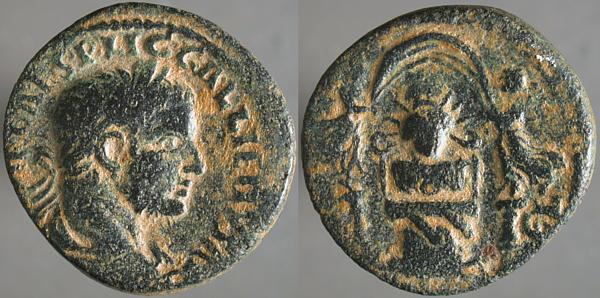
IMP CAES P LIC GALLIENVS AVG, Laureate draped cuirassed bust right | [CO_L H]_EL, Radiate Tyche of Heliopolis seated facing on throne, under inflated veil held by two female figures.
The most famous Heliopolis is discussed here, a city of ancient Egypt near modern Cairo. This coin is from a different Heliopolis, today Baalbek in Lebanon's Bekaa Valley.
Monday, September 12, 2005
Æ antoninianus, Gallienus, Mediolanum, Göbl 1391a
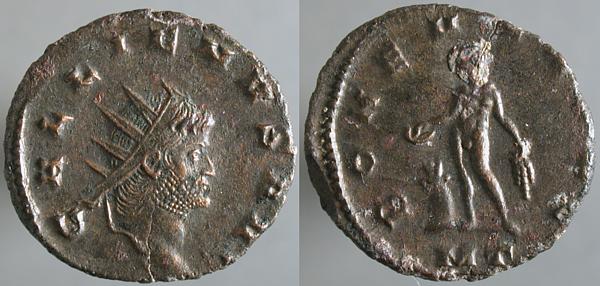
GALLIENVS AVG, Radiate head right, one ribbon behind, one forward across shoulder | BON EVEN AVG, Bonus Eventus, nude, standing facing, head left, holding grain ears right, sacrificing from patera over flaming altar left, MT in exergue.
(continued one post down)
(Let me take the opportunity here to point out that one of the primary motives for starting this blog was the belief that many people could do a better job of this than I and that some would be motivated to prove it. C'mon somebody, make me look
Æ antoninianus, Gallienus, Mediolanum, Göbl 1391c
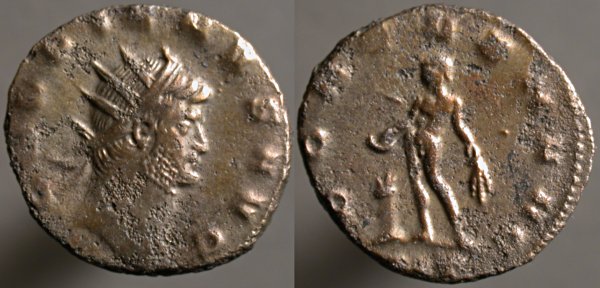
GALLIENVS AVG, Radiate head right, both ribbons behind | BON EVEN AVG, Bonus Eventus, nude, standing facing, head left, holding grain ears right, sacrificing from patera over flaming altar left, MT in exergue.
Two posts, two coins today, very similar. This one with both of the ribbons attached to the radiate crown hanging free behind the head, the one below with one of the ribbons instead forward across the shoulder. Every bust of Valerian or Gallienus has one or the other arrangement, and often the same reverse exists with obverses of both kinds, though usually in very different quantities.
Whether this is just the preference of individual engravers, or whether it has some unfathomable significance, I won't even speculate.
Sunday, September 11, 2005
Æ25, Nicaea & Byzantium in Bithynia, Valerian, Sear GIC 4435
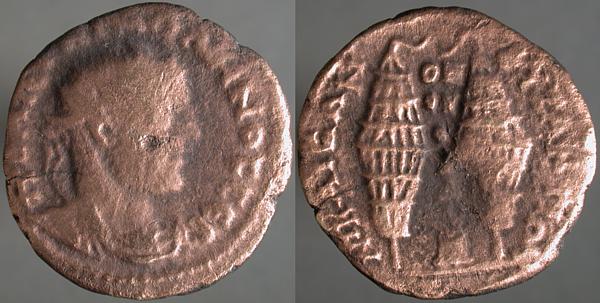
ΠOY ΛIK OYAΛEPIANOC CE, Radiate draped bust right | NIKAIEΩN BYZANTION, Two baskets of grain, OM / ON / O / IA between.
The reasons for Homonia (OMONOIA) coins like this, jointly issued by two cities, are imperfectly understood. These cities had little or no political autonomy, so this cooperation between cities is a practical matter, presumably sharing the cost of something. Both Nicaea and Byzantium minted their own coins at this time, so they had the resources to do that. The coin doesn't refer to any games, so there's no reason to think they were cosponsoring an extravagant celebration.
In 324 Byzantium became Constantinopolis and, in 1930, Istanbul.

